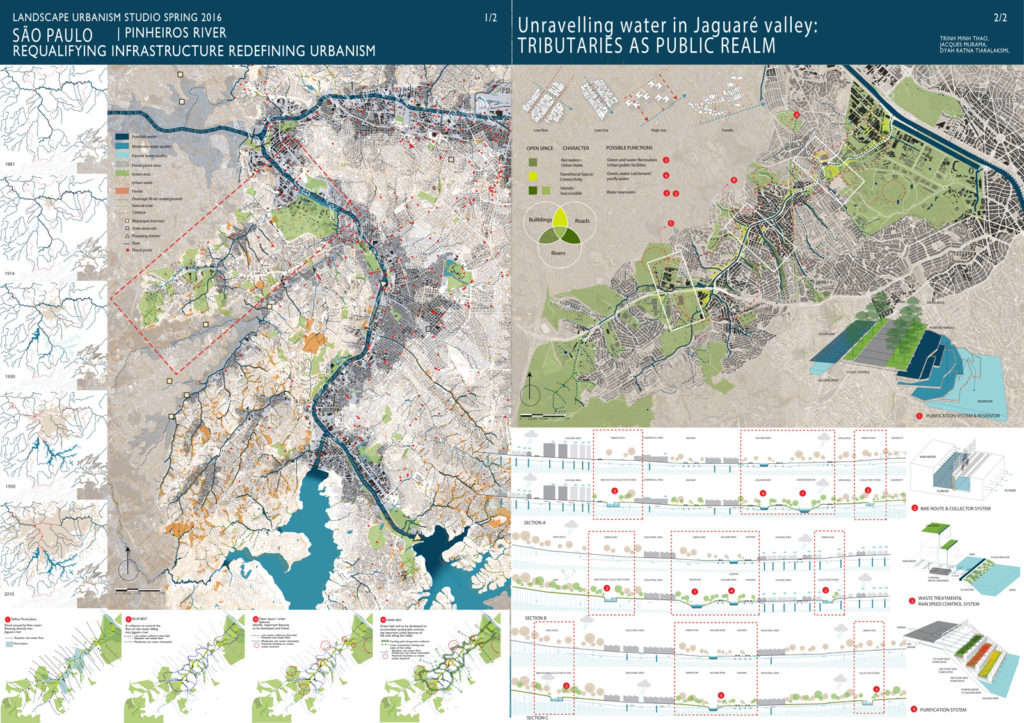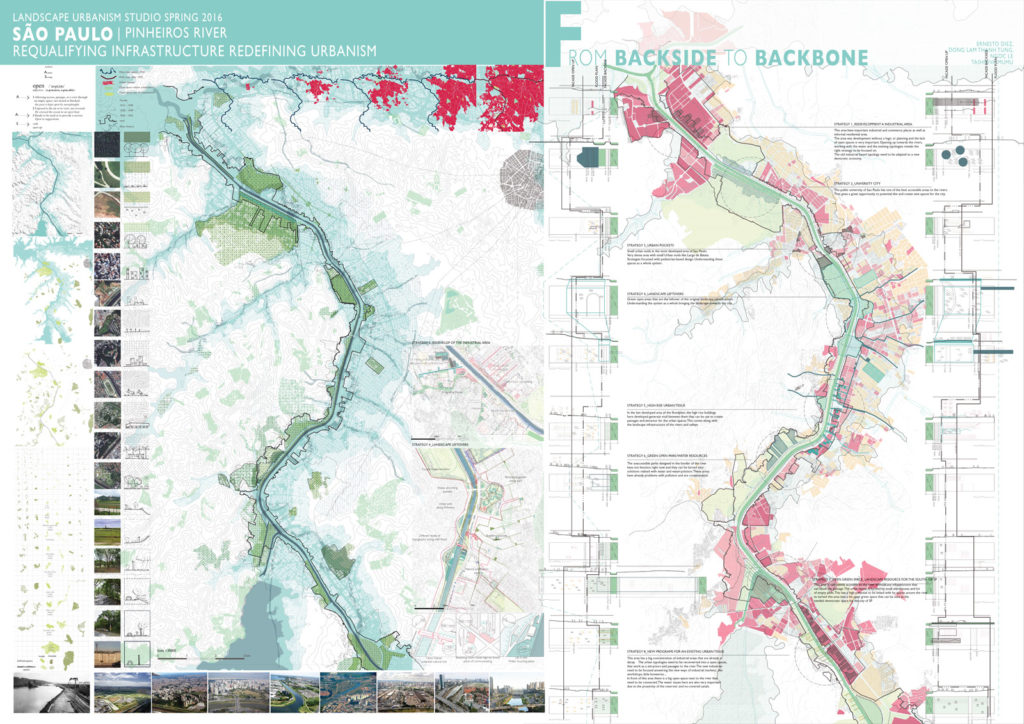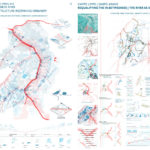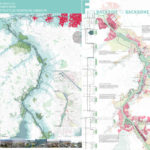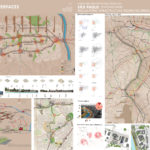REQUALIFYING INFRASTRUCTURE, REDEFINING URBANISM
Eliana R . de Queiroz Barbosa, Patricia Capanema A. Fernandes
São Paulo is full of dichotomies and contradictions.
Regarding urban form, everywhere, everything seems to go ver tical whereas the city presents itself as an urbanized horizontal carpet.
Its center is marginalized whereas its margins are occupied by booming centralities.
Real estate led redevelopments have destroyed well- functioning neighborhoods and replaced traditional housing typologies, yet the city still has 30% of its housing units in some kind of informality and precarious living conditions.
Mobility infrastructure provision has been deficient over the past years and the current system is inefficient, yet it involves around 23 million travels per day, each day.
The city presents itself as a powerful concrete jungle, yet it has to surrender regularly to the forces of nature.
The territory where today São Paulo lays was first occupied between two main rivers, its floodplains and its tributaries. During the twentieth century, the city expanded its infrastructure according to a road-based urbanism, occupying the inner city’s environmentally sensitive areas, and manipulating its rivers – which are still today used as a backbone for development.
A decade of speculative urban development, infrastructural crisis and water collapse set the prospect to redefine urban development, while re-considering infrastructural provision. The infrastructural crisis offers the oppor tunity to work with landscape rather than against it, interacting man-made forces with natural ones in a more sustainable way. Infrastructure is thus reconsidered in three ways:
(1) As the anchor of an alternative development and the trigger of new forms of urbanity;
(2) As landscape and therefore as means to reinforce and create structures defining the city;
(3) As the backbone of innovative mobility scenarios.
By using the River Pinheiros and its surrounding neighborhoods as cornerstone sites, the studio proposes to unravel the megalopolis’ dichotomies by exploring possible new relations between infrastructure and landscape. Segments and sections will be used, with topography playing an impor tant role to perceive the São Paolo’s natural and urban conditions.
Studio method: .
The landscape urbanism design research studio will address urban redevelopment of Pinheiros River hydraulic system and its surrounding area in the context of the infrastructural and environmental crisis. While doing so, the studio will:
– Approach the interplay of scales and time frames, when considering landscape logics and infrastructural networks.
– Design for complexity, incorporating transformation and uncer tainty of programs.
– Outline scenarios for recycling urban infrastructure that consider juxtaposition, adaptation, transformation, redefinition, reconciliation and deconstruction and reconstruction.
In a context of paradigm shift, crisis and uncer tainty, the studio contribution to the area’s problematics will seek to stimulate debate and raise discussion within the districts’ planning and policy depar tments and inform politics. As a means to this end, the studio will focus throughout the semester on developing critical questions as problem formulations and research/ design topics.
Different phases of reflection and design will structure the semester:
Interpretative Mapping
– Combining ‘above’ (historical & contemporary mapping) and ‘below’ (fieldwork – projective & active description)
– Formulation of a working hypothesis on the relations between infrastructure and nature for the upcoming future, envisioning a new role for infrastructure in the (future) city.
Urban Visions and Scenarios
– Test an infrastructural paradigm shift for the upcoming future, envisioning the distinct roles for infrastructure.
– Reconcile Landscape and Infrastructure, while addressing conflicts and oppor tunities.
Design Strategies
– Operate visions and scenarios
– Mediate and organize functions, materials and actors.
– Unite and canalize different contested urban forces
– Present structural impact and leverage effect
LANDSCAPE URBANISM STUDIO SAO PAULO | PINHEIROS RIVER PARTICIPANTS
Elvia Costas, Caroline Custine, Ernesto Diez, Parul Jain, Minh Ngoc Le, Jacques Murama, Joan Nyagwalla, Giovanna Pittalis, Tasniva Rahman, Trinh Minh Thao, Dyah Ratna Tiaralaksmi, Dong Lam Thanh Tung, Ioannis Vorgias, Ashraf Zaman
STUDIO COORDINATION
Bruno de Meulder, Vviana d’Auria
STUDIO GUIDANCE
Eliana Rosa de Queiroz Barbosa, Patricia Capanema Alvares Fernandes
[DE] CONSTRUCTING SÃO PAULO [De] Constructing São Paulo
[DE] CONSTRUCTING SÃO PAULO INTERNATIONAL WORKSHOP
16-25/02/2016
ORGANIZATION:
Eliana R. Queiroz Barbosa, Patricia Capanema A. Fernandes, Pedro M.R. Sales
PARTICIPANTS:
Ashraf Zaman, Ariela Vicensotto De Giuli, Camila Apollaro, Caroline Custine, Daniela Rizzi, Dyah Ratna Tiaralaksmi, Elvia González Costas, Ernesto Diez Martinez, Fabiola Avamileno, Giovanna Pittalis, Guilherme de Oliveira Pucci, Ioannis Vorgias, Jacques Murama, Jéssica Cavalcante Schussel, Joan Nyagwalla Otieno, Julia Godinho, Juliana Katayama, Laura Bellotti, Luiz Felipe Orlando, Maísa Veloso Rio Lima, Marina Dahmer, Matheos Schnyder, Minh Ngoc Le, Parul Jain, Raquel Sanches Manfredini, Raphael F. do Amaral Tafner, Tasniva Rahman Mumu, Thanh Tung Dong Lam, Trinh Minh Thao, Wagner de Souza Rezende, Yuri Bassichetto Tambucci
COLABORATORS:
Jeroen Stevens, Nadia Somekh, Matheus Tenuta, Mauro Caliari, Newton Massafumi Yamato, Sarah Har tmann
LECTURERS:
Caio Ferraz, Carolina Heldt D’Almeida, Denise Pessoa, Fabio Mariz Gonçalves, Fabio Valentim, Laura Sobral, Maria Angelina B. Ribolla, Marco Antonio Palermo, Marcos Boldarini, Maria Stella Cardeal de Oliveira, Mario Reali, Patricia Marra Sepe, Tácito Pio da Silveira


